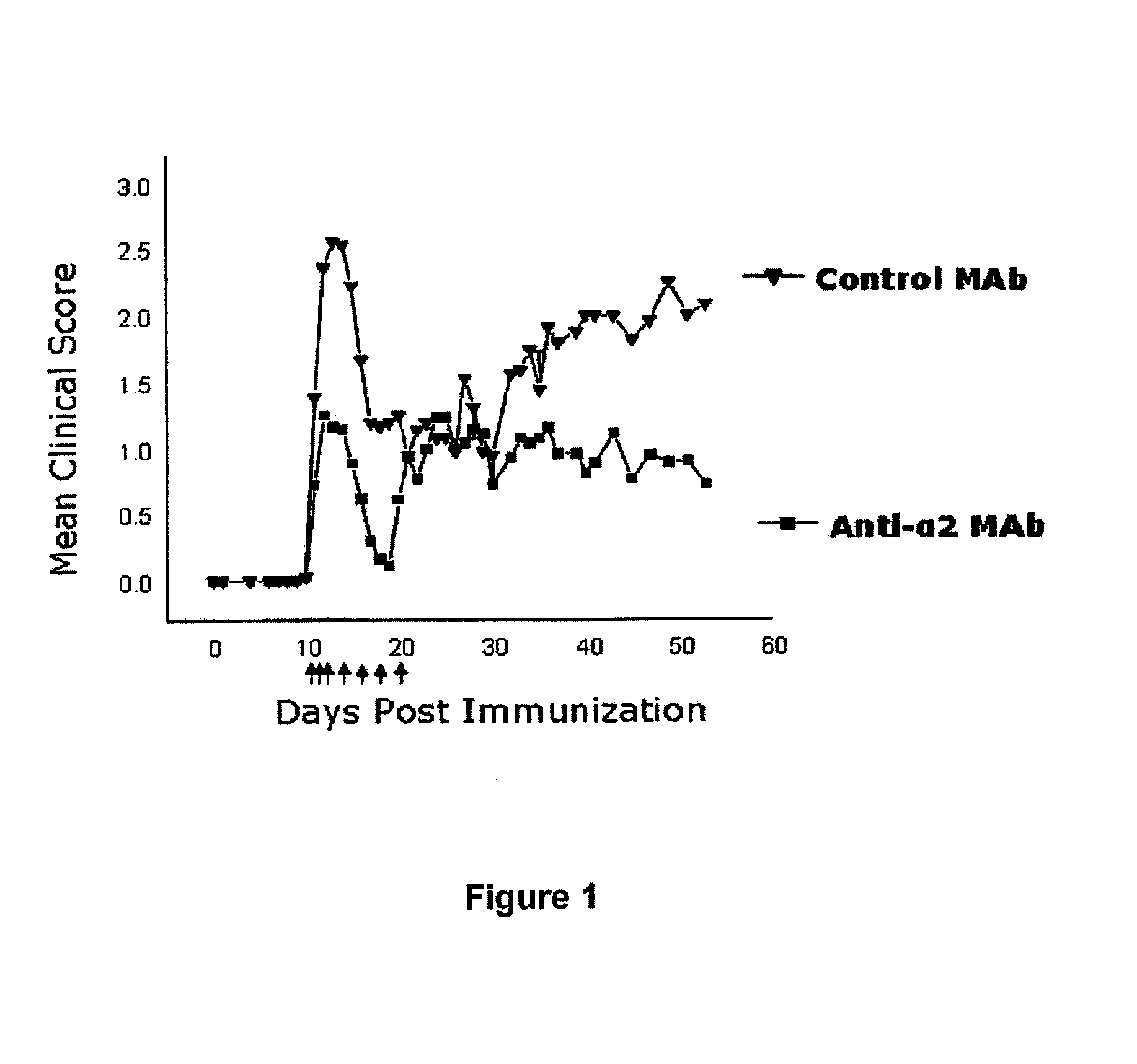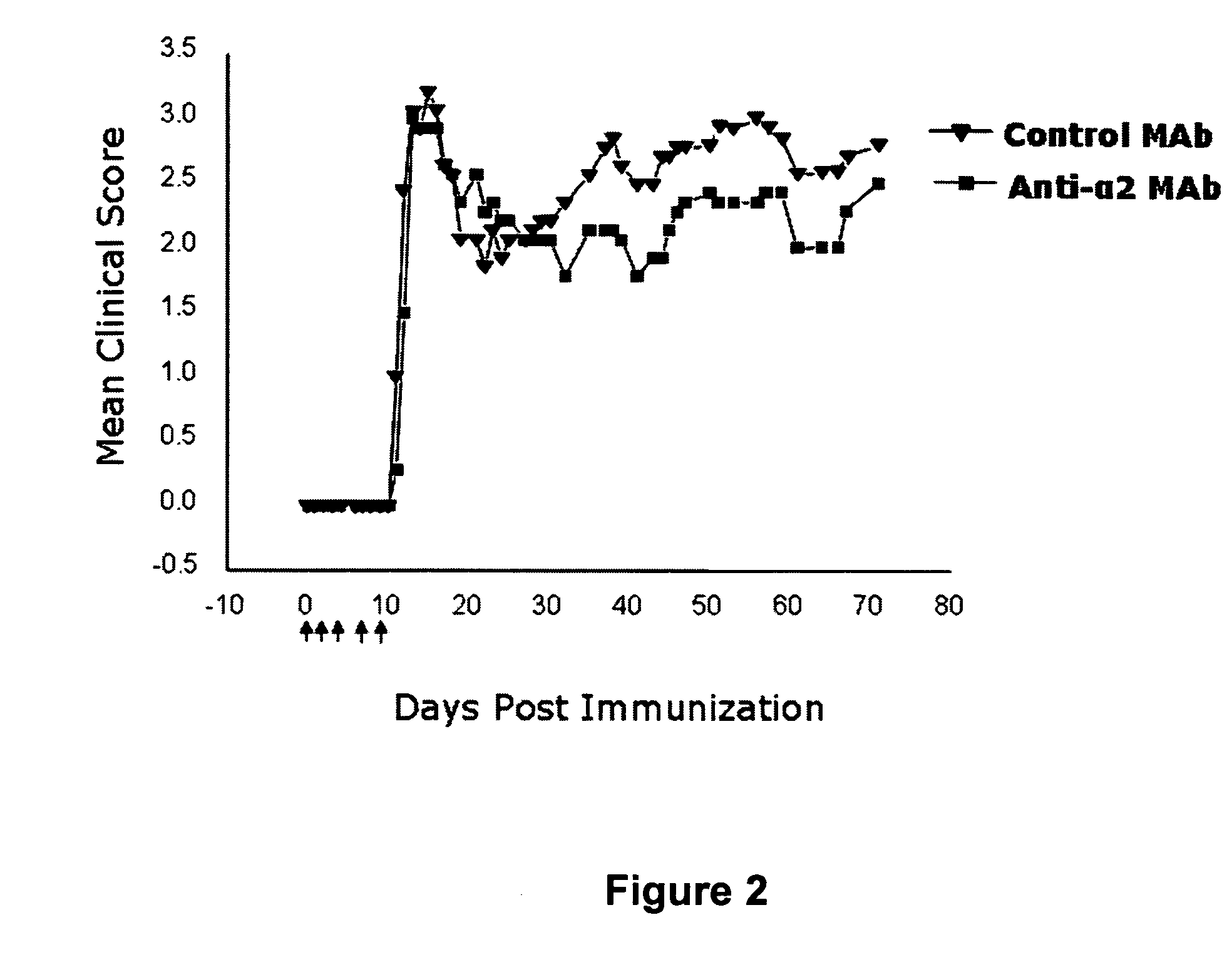Anti-α2 integrin antibodies and their uses
a technology of integrin and anti-integrin, applied in the direction of antibody ingredients, connective tissue peptides, pharmaceutical non-active ingredients, etc., can solve the problems of thrombocytopenia and bleeding complications, platelet thrombotic responses, bleeding complications, etc., to facilitate efficient uptake of therapeutic genes, specific “homing” properties, and increase transgene transfer efficiency
- Summary
- Abstract
- Description
- Claims
- Application Information
AI Technical Summary
Benefits of technology
Problems solved by technology
Method used
Image
Examples
example 1
[0231]Antibodies with specificity for α2β1 integrin were designed and prepared. The previously unknown sequences of variable regions of a murine antibody designated TMC-2206 secreted by the hybridoma BHA2.1 were determined as described herein. The VH and VL cDNAs were cloned from mRNA from BHA2.1 hybridoma cells by RT-PCR using one set of primers corresponding to amino acids at the N-terminus of the murine variable region of the heavy (VH) or light (VL) chain, and a second set of primers corresponding to the respective heavy γ1 and κ light chain constant regions. The sequence was determined from cDNA that had been synthesized from mRNA isolated according to standard methods is described herein.
[0232]Cytoplasmic mRNA was isolated from approximately 1 million (1×106) BHA2.1 hybridoma cells expressing TMC-2206 using standard molecular techniques for those skilled in the art. To isolate poly A mRNA, cells were lysed in 5M guanidinium thiocyanate, mixed with oligo (dT) cellulose (Ambion,...
example 2
[0242]Chimeric antibodies with specificity for α2β1 integrin were designed and prepared, including mouse-human chimeric antibodies. VH and VL regions of the cloned TMC-2206 as described in Example 1 were used to design and prepare chimeric heavy and light chains, respectively, using standard molecular cloning techniques (see, e.g. Molecular Biology Manual by Sambrook and Russell, 2001).
[0243]Heavy and light chains were cloned with the introduction of restriction sites as follows. The primers, TMC-2206-r5′ CCCGAATTCACAGGTGCAGTTGAAGGAGTCA SEQ ID NO:22) and TMC-2206-r3′ CGGGATCCTTAGGATCATTTACCAGGAGAG TGGGA (SEQ ID NO:23), were used to clone out the TMC-2206 heavy chain by RT-PCR from BHA2.1 hybridoma mRNA and the primers TMC-2206-k5′ CCCGAATTCACAATTTGTTCTCACCCAGTCT (SEQ ID NO:24) and TMC-2206-k3′ CGGGATCCTTATCTCTAACACTCATTCCTGTTGAA (SEQ ID NO:25) were used to clone out the TMC-2206 light chain. These primers introduced EcoRI and BamHI sites at the 5′ and 3′ ends, respectively, to allow...
example 3
[0254]Humanized antibodies with specificity for α2β1 integrin were designed and prepared. Residues of the cloned TMC-2206 antibody that comprise the CDR regions of the heavy and light chains were determined and humanized variants were prepared as follows. Three regions of hypervariability within the less variable framework regions are found in both the heavy and light chain variable regions. In most cases, these hypervariable regions correspond to, but may extend beyond, the CDRs. The amino acid sequences of the TMC-2206 heavy and light chain variable regions are specified above in Tables 3 and 4, respectively. The CDR and framework regions were elucidated generally in accordance with Kabat by alignment with other VH and VL regions using general homology searches using the NCBI protein BLAST database Ye et al., Nucleic acids Res., Jul 1: 34 (Web Server Issue): W6-9)), except for HCDR1. HCDRI was defined by the AbM definition as spanning residues 26 to 35. The Oxford Molecular's AbM ...
PUM
 Login to View More
Login to View More Abstract
Description
Claims
Application Information
 Login to View More
Login to View More - R&D
- Intellectual Property
- Life Sciences
- Materials
- Tech Scout
- Unparalleled Data Quality
- Higher Quality Content
- 60% Fewer Hallucinations
Browse by: Latest US Patents, China's latest patents, Technical Efficacy Thesaurus, Application Domain, Technology Topic, Popular Technical Reports.
© 2025 PatSnap. All rights reserved.Legal|Privacy policy|Modern Slavery Act Transparency Statement|Sitemap|About US| Contact US: help@patsnap.com



